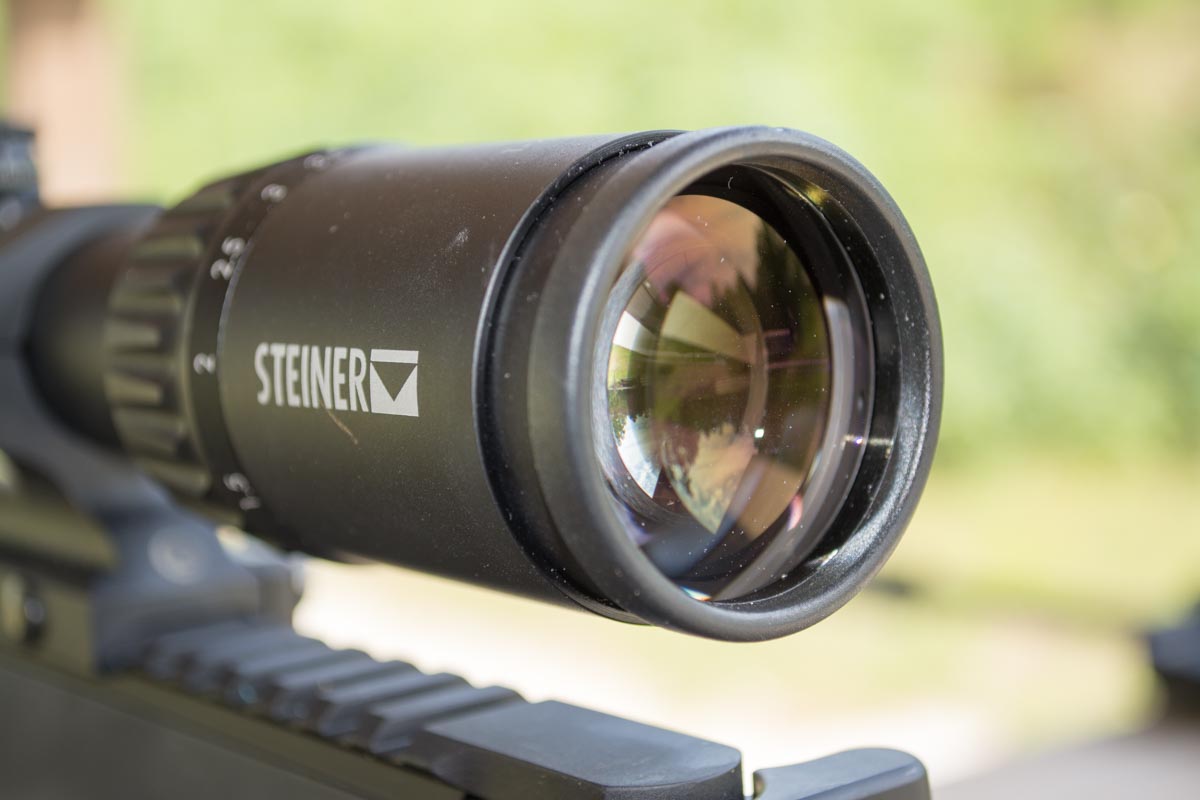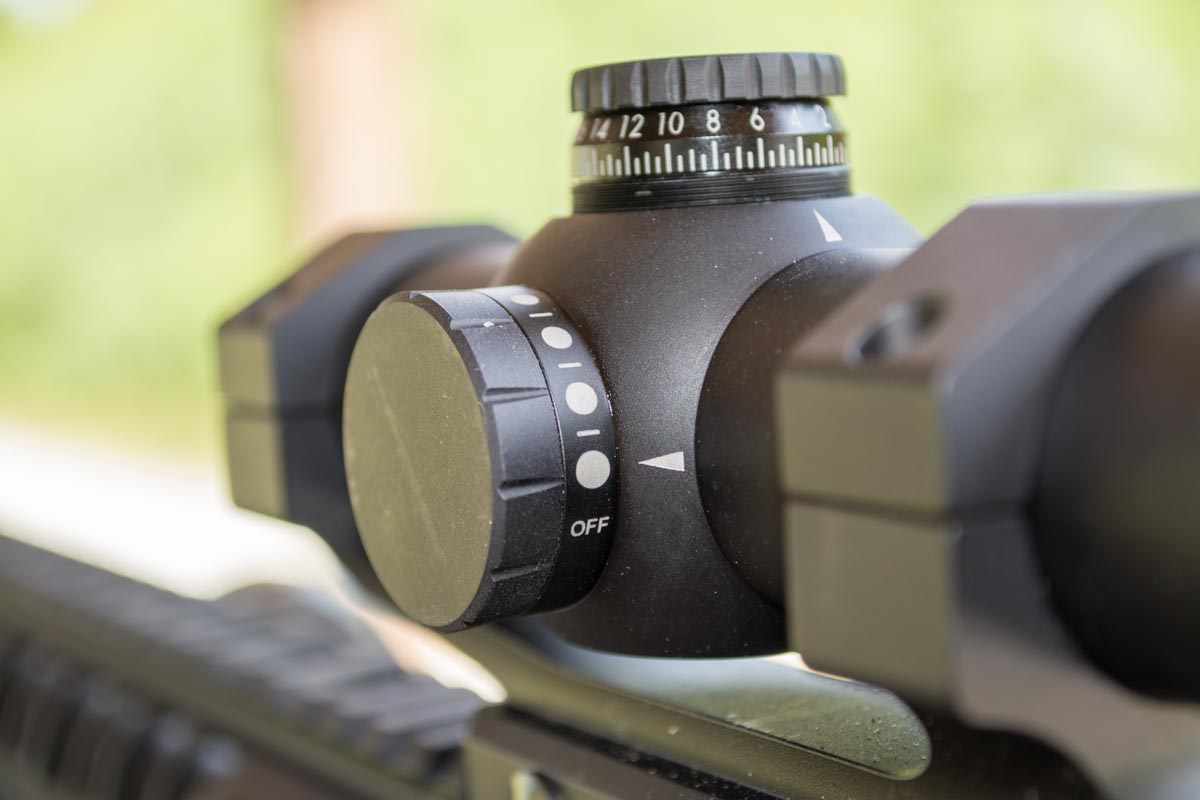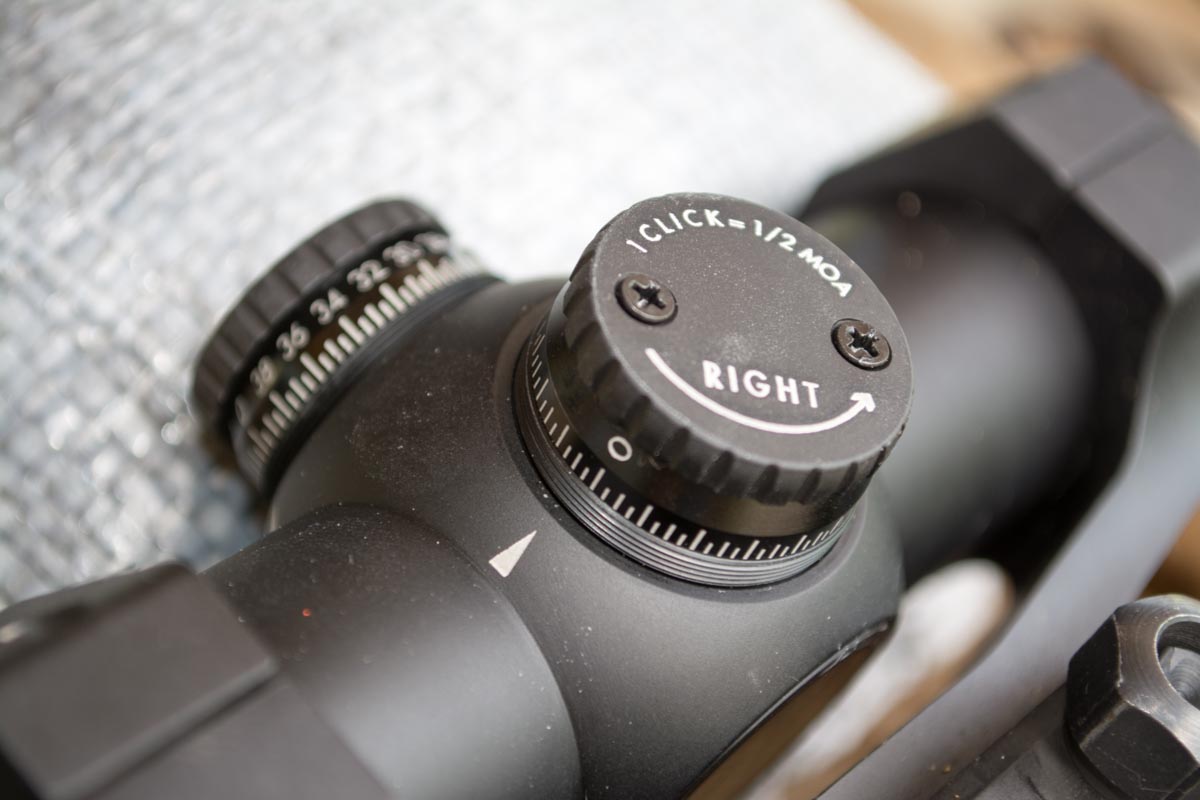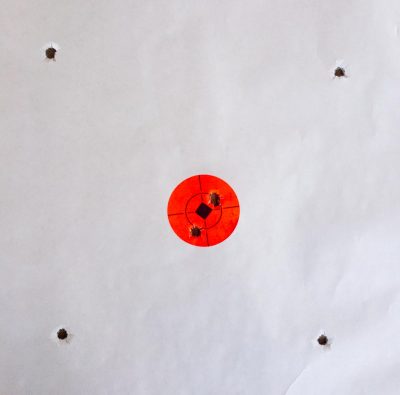Field Test: Steiner P4Xi 1-4×24 Riflescope
Tom McHale 09.25.17

Choosing the perfect optic for AR-type rifles is a challenge. I can’t tell you how many times I find myself waffling between a 1X power reflex sight and something with a little magnification juice. Generally speaking, I’m in favor of lower magnification wherever possible. The benefits of improved field-of-view, more clarity, and faster target acquisition almost always (at least for me) outweigh the upside of seeing a distant object in just a little more detail.
Let’s take a look at an option that offers some of the best of both worlds — the Steiner P4Xi 1-4×24 Riflescope.
A Quick Tour
While it can be used on whatever you want, the Steiner P4Xi is optimized for a modern sporting rifle (MSR) — either an AR-15, AR-10 or most anything else similar that’s chambered in 223 Rem./5.56mm or 308 Win./7.62mm. It’s ideal for the MSR platform due to its compact nature and reticle. We’ll get into the details of that in a minute.
Small and compact, it weighs in at 17.3 ounces — just over a pound. It’s a 30mm, nitrogen-filled tube that has an overall length of 10.3 inches. The scope is a 1-4x variable magnification design. Like the Steiner T5Xi we looked at recently, the magnification wheel has deep texture and a rubbery feel, so it rotates smoothly but stays in the position you choose. In keeping with the low-profile nature of this scope, there’s no throw lever included, but you could certainly add one if you like.
While we’re talking about magnification, I should mention that this is a fixed parallax optic; it’s focused at a distance of 100 yards. Considering the intended use of this scope, that’s just fine. You don’t need parallax adjustment for service rifle ranges, and even if you look through it a little off kilter, the affect downrange to point-of-impact will be minimal. The lowest power of magnification is a true 1X, so you can use this as a red dot at closer ranges. Of course, as with any magnified optic, you need to be sensitive to the 3.5- to 4-inch eye-relief zone to get a full and clear sight picture. The scope itself is waterproof to 33 feet, so if you want to swim at the beach with one, you can, but in more practical terms that means you don’t have to worry about rain and humidity.

The turrets are covered with screw-on caps and aren’t intended to be adjusted in the field on a shot-by-shot basis. They exist for zeroing the optic to your specific rifle, mount, ammunition choice, and preferred distance. Both the windage and elevation adjustment dials adjust in 1/2 MOA adjustments, so each click moves the point-of-impact a half-inch at 100 yards. You have a total of 100 minutes of angle of possible adjustment for both windage and elevation, which should be plenty to account for even a slightly off-center mount.
The reticle is the Steiner P3TR; here’s what that means. It’s a traditional crosshair design with a series of stadia below the center. If you zero the P4Xi at 200 yards, then those range compensation lines correspond to 300, 400, 500, and 600 yards as you move down. If you don’t have a 200-yard range to zero, no worries. Just zero the optic at 50 yards, and you’ll be within a fraction of an inch of dead-on at 200, assuming you use a standard-height MSR scope mount. By my math, you’ll be 1-inch high at 200 and cross the exact aim point at about 220 yards using a 3,000 fps, 55-grain .223 bullet.
You might remember earlier that I said this scope works well for the 308 Win., too. Using a 150-grain bullet traveling at 2,820 fps, the same 50-yard zero will land you .75-inches high at 200 yards. At 500 yards, both the 223 Rem. and 308 Win. bullets drop within an inch of each other with a fall of about 44 inches. The trajectories between the two calibers are very similar, so the Steiner folks averaged them out to create the hold lines for 300 through 600 yards.
If you want to use this optic for other bullet profiles or different calibers, no worries. Steiner publishes the line positions in minutes of angle so you can calculate the exact distance for each of the four stadia lines for your specific rifle and ammo. The guide also has information on the width and height of various indicators in the reticle so you can use it for basic range determination, too. In keeping with the “ranging standard,” those are published in milliradians.

The reticle is also illuminated with a bright center dot. That comes in handy when you’re using the 1 or 1.5X settings in either daylight or low-light conditions. The illumination feature is powered by a standard CR2032 battery that’s available most anywhere, and it features 11 different intensity settings. The lowest two are for night vision use, while the next four up the scale are for low-light applications. The brightest five settings are best for daylight use if you want the dot in view. The wheel on the left side of the scope body controls illumination. A nice feature is that there is an “off” setting between each intensity level setting so you can go right back to your desired light level with a single click.

Shooting with the P4Xi

I mounted the Steiner P4Xi on a Stag Arms 10s M-Lok rifle. That’s an AR-10 chambered in 308 Win. Since 308 Win. and 223 Rem. (using the traditional and most popular loads) are so ballistically similar regarding trajectory, the P4Xi is a great fit on either the AR-15 or AR-10 platforms. So, why not bring out the big guns to test out this optic? From previous accuracy tests of this rifle with a variety of ammunition, I know that it shoots five-shot groups in the 1-1/2-inch diameter range at 100 yards. Some ammo groups a hair bigger and some a hair smaller.
One of the things I always try to do when testing scopes is shoot a modified “box” test. The goal of this exercise is to see how well the scope performs when you make a boatload of windage and elevation “click” adjustments. When you make a sizable adjustment, does the bullet impact where it should? In other words, if the dial says you’re moving the impact point 8 inches down and 4 inches to the left, is that where the bullet really strikes? Secondarily, after making adjustments, when you move the windage and elevation dials back to zero, does the shot still impact where it used to before all that frantic clicking and spinning?
The box test validates two things. First, it gives you an idea as to whether each click on the turrets is precise, meaning that a click moves the amount that it should and that each click adjusts exactly the same amount as every other click. Second, the box test gives you some perspective on repeatability. Do the adjustments bring you right back to the exact place you started?
Here’s how I did the box test shown here. After zeroing the rifle so that point-of-impact matched the point-of-aim, I fired a shot at the bull’s-eye on a target 50 yards downrange. Then I adjusted elevation down 16 clicks (4 inches at 50 yards) and windage right the same amount. Firing a second shot while holding on the center bull’s-eye caused an impact 4 inches down and 4 inches to the right of the first. I then adjusted straight up 32 clicks — that’s 8 inches at 50 yards to shoot the upper right corner of the box. Continuing on similarly until all four corners were fired, I ended by adjusting windage and elevation back to the starting point. As you can see by the photos, this exercise resulted in a near-perfect box pattern with two shots — the first and last — both in the center. The P4Xi did a wonderful job on adjusting as it should and returning back to zero after all those clicks.
To sum things up, I found this optic to be plenty fast at any power level. One thing I didn’t mention before when talking about the reticle is the tapered crosshairs. They start at the edges of the field-of-view nice and thick, so they’re easy to pick up. As each approaches the center, they gradually taper down to a finer width for better aiming precision. The net effect is great —bring this rifle to shoulder and you’ve instantly got a clear view and centering the target is fast and intuitive. Like everything else from Steiner, it seems to be built like a tank and offers fantastic visual clarity, even all the way out to the edges. MSRP for the Steiner P4Xi 1-4×24 Riflescope is $670.

